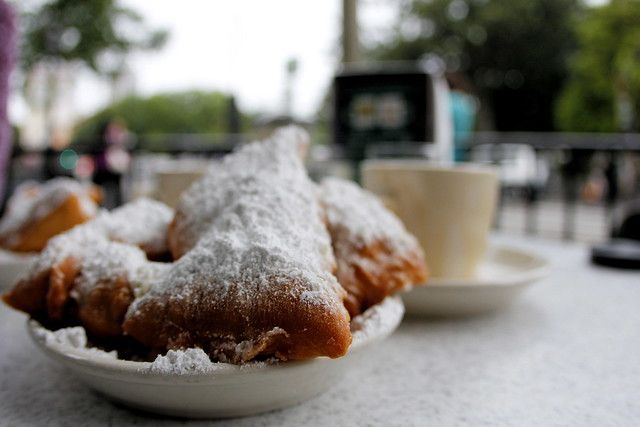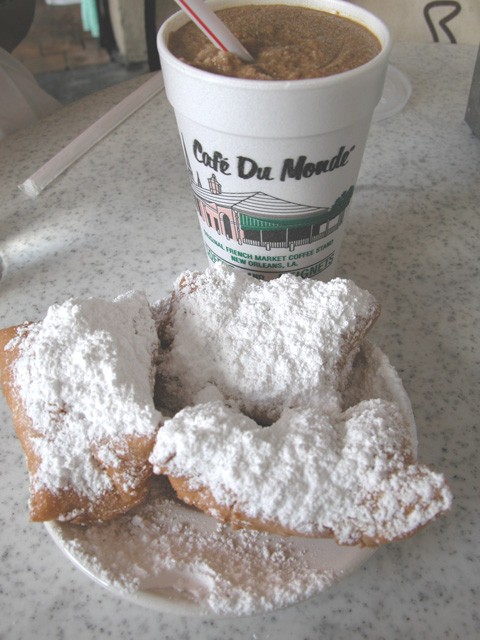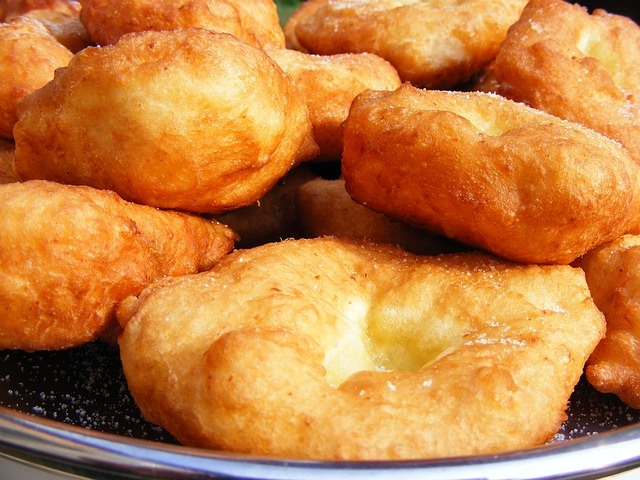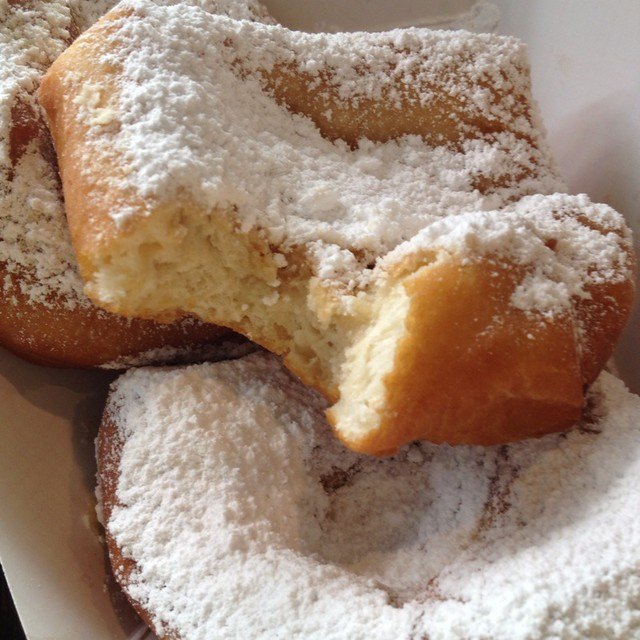If you’ve ever been to New Orleans, you may have heard of—or tasted—the iconic beignet. If you haven’t, you’re in for a treat!
Beignets are a type of donut. Unlike most donuts, however, they don’t have a hole in the center, and they’re much lighter and fluffier. Despite this, it’s not hard to understand why they’re worthy of the title Louisiana has given them – the best donut in the state!

But what is a beignet? Also known as New Orleans donuts, beignets are a type of sweet dough. They are cousins to the English fritter, but are shaped like a pillow and deep-fried in oil.
They are made with flour, milk, eggs, sugar, and yeast, all of which are fried and then topped with a heap of powdered sugar. When served warm, the beignet has a crunchy exterior with a soft, pillowy interior – all while the powdered sugar melts in your mouth.
Beignets are often served during Mardi Gras, but you don’t have to be celebrating to have a plate (or two) of this tasty treat. In fact, it’s so easy to prepare and cook, you can do it right at home with some kitchen staples!
Contents
Origin and History of the Beignet
In the modern-day, we know the beignet alongside the equally decadent Mardi Gras, especially in New Orleans. In fact, it’s considered to be the official Louisiana donut!
However, beignets came from much farther than the streets of New Orleans.
The beignet starts its journey in Spain, all the way back in the middle ages. They were called pets de nonne, also known as Spanish beignets. These pastries were made of light and airy choux paste, and were cooked by deep-frying.
The recipe then made its way to Mediterranean France, at least around the 16th century. There are records of them being celebrated alongside French Mardi Gras, and many recipes for beignets can be found around this time.
During the 18th century, colonists brought the recipe to the United States, alongside other French dishes, like compotes and soufflés. The Creole people of Louisiana adopted the custom, and the beignet eventually found its way to New Orleans, as well as to other parts of the United States.
At present, the beignet was a huge influence in New Orleans, going beyond a dish celebrated alongside Mardi Gras. It’s the official donut of the state, and New Orleans also houses the famous Café du Monde.
Café du Monde was originally established in the New Orleans French Market as far back as 1862. Still operating to this day, Café du Monde is considered a state landmark.
Despite its age, it continues to be a huge hit among both tourists and locals; in fact, it operates twenty-four hours a day, seven days a week. In Café du Monde, there is only one dish that you can order: beignets.
In fact, you don’t have to specify what you’re ordering; “an order” will always refer to a plate of beignets.
The beignets of Café du Monde come in threes, which is rarely a problem, because you will easily be able to finish three all by yourself.
Their menu comes with a variety of drinks, from juices to soda. But the most important drink on their menu is the café au lait.
See more: another imported favorite – the bomboloni donut.
Cafe Au Lait Origins
The history of this New Orleans famous pastry is not complete without its companion, the café au lait. Just like the beignet, the cafe au lait can be traced back to the 1800s.
It’s made with equal parts coffee and milk, with a dash of chicory. Chicory, specifically its root, adds a robust flavor to coffee; it’s slightly more bitter, but less acidic, giving café au lait its iconic taste.
Chicory in coffee was originally a way of stretching limited coffee rations. During Napoleon’s Continental blockade of 1808, coffee became scarce. Chicory, a plant native to France, had a taste similar to coffee. It didn’t have caffeine, but it was close enough, making it an occasional substitute for coffee itself.
While the addition of chicory was invented in France, it was brought to the United States alongside the beignet. Chicory made its way to Louisiana, one of France’s colonies, and came to the rescue when coffee became scarce due to the Civil War.
Again, chicory was used to stretch the limited coffee supply, supplementing the flavor in weak brews. At the end of the Civil War, the practice of adding chicory to coffee is still popular in Louisiana, especially in New Orleans.
It was the world-famous Café du Monde that popularized the pairing of the beignet and the café au lait. At present, it’s hard to find a good cup of café au lait far from a plate of beignets.
However, you don’t have to go all the way to New Orleans just to have a plate of this pillowy goodness. You can easily make your own, right at home, with just a few simple ingredients.
How to Make Beignets
Beignets are the perfect snack for sweet-tooths.
This recipe takes the classic New Orleans pastry, the kind that you would find at Café du Monde, and turns it into an easy homemade dish.

Ingredients
- 3/4 cup of lukewarm water.
- 1 packet (1/4 ounce) of active dry yeast.
- 1 large egg.
- 1/2 cup of evaporated milk.
- 1 teaspoon of vanilla extract.
- A pinch of salt.
- 1/3 cup of sugar.
- 3 3/4 – 4 cups of all-purpose flour.
- 3 tablespoon of melted butter.
- Corn oil or any flavorless oil for frying.
- Powdered sugar for dusting.
Method
- Bloom the yeast. To do this, combine the lukewarm water and yeast in a large bowl or stand mixer. Let it sit for five minutes. The yeast should begin to bubble.
- In a separate bowl, whisk the eggs, evaporated milk, vanilla extract, salt, and sugar. Add this to the yeast mixture.
- Slowly mix two cups of flour into the bowl. If using a stand mixer, choose a dough hook. Mix for about two minutes.
- Then, add the melted butter. Mix until the dough is only slightly sticky. Add more flour if the dough is too sticky.
- Lightly flour a surface and knead the dough for about one to two minutes.
- Grease a medium-sized bowl and turn the dough to grease its surface. Cover the bowl loosely with a clean cloth and place in a warm, draft-free place. Let rise for about two hours, or until the dough has at least doubled in size.
- After rising, remove the dough from the bowl, and punch it down to release the extra air.
- Roll out the dough on a lightly floured surface. It should be ¼- to 1/3-inch thick.
- Cut out squares from the dough, measuring about 1 ½ to 2 inches on each side.
- Fill a pan with oil (about two inches deep) and fry the dough squares in batches. Fry each side until they are puffy and golden brown, about three to four minutes total.
- Wipe off the excess oil on paper towels.
- Dust with powdered sugar, and serve warm.
Here’s a video with an example of how to make beignets.
Baked Beignets
While deep-frying is a part of the beignet’s charm, we have to admit it doesn’t make the dish any healthier. If you want a health-conscious, baked version of the beignet, this recipe has you covered.
This is also a great twist for people who want to save up on oil. It’s less hassle since your oven does half of the work!
Ingredients
- 1/2 cup of whole milk.
- 1/3 cup of buttermilk.
- 2 teaspoons of active dry yeast.
- 2 teaspoons, plus 1 teaspoon, of sugar.
- 1 3/4 cup of bread flour.
- 1/2 teaspoon of baking soda.
- 1/8 teaspoon of salt.
- 2 teaspoons of unsalted butter, at room temperature.
- Confectioners’ sugar.
Method
- Heat milk over medium-low heat in a saucepan until warm to the touch. Take off heat, and whisk in buttermilk, 1 teaspoon sugar, and yeast. Let stand for five minutes to let the yeast bloom.
- In a different bowl, whisk together flour, baking soda, and salt.
- Fit a dough hook in your stand mixer and pour your yeast blend in the bowl. Add the flour mixture, the rest of the sugar, and butter to the mixer. Mix until the ingredients are well combined. Then knead for five more minutes.
- Loosely cover the bowl with a towel and let sit in a warm, draft-free place for about forty minutes, or until the dough has doubled in size.
- Lightly flour a surface, and roll out the dough into a rectangle that’s half an inch thick. Cut the dough into rectangles, measuring about one by two inches.
- Line two baking sheets with parchment paper. Place the rectangles on a baking sheet. Loosely cover with a towel, and let rest for twenty minutes.
- Preheat the oven to 400 degrees Fahrenheit. Bake for about twelve minutes, or until the beignets have puffed and are golden brown.
- While still hot, roll the beignets in confectioner’s sugar.

Beignets Without Yeast
Traditional French beignets are made with yeast, giving them that iconic texture and flavor. However, working with yeast means that you’ll spend more time kneading and waiting for the dough to rise.
Thankfully, you don’t have to choose between authenticity and convenience.
Choux pastry is also a traditional way of baking beignets, and it doesn’t need yeast. It’s the dough used in baking cream puffs and eclairs, and the moisture in the dough allows it to rise.
These beignets don’t have the pillow shape of the classic beignets; however, they taste just as good.
This recipe for choux pastry dough should take no more than an hour – or even less!
Ingredients
- 1/2 cup of butter.
- 1 cup of water.
- 1/4 teaspoon of
- 1 cup of all-purpose flour.
- 4 eggs.
- Oil (for deep frying).
- 3 tablespoons of powdered sugar.

Method
- In a medium saucepan, melt the butter in the water, and remove the pan from the heat. Transfer the mixture in a medium bowl.
- Add salt and flour, and stir until a batter is formed. The batter should be slightly sticky at this point. If the dough is still hot, allow it to cool until it is cool enough to be touched.
- Add the eggs to the mixture, beating in the eggs one at a time.
- Add oil to the pan, at least two inches deep. Check to see if the oil is hot enough by dropping a bit of the dough into the pan; it should immediately float to the surface and puff up. Alternatively, you can use a thermometer; the temperature should be at 375 degrees Fahrenheit.
- Take a teaspoon of the dough and drop it in the oil, a few at a time, making sure that the fryer isn’t crowded. Leave the dough in the oil for about six minutes, flipping the dough when necessary. They should be a light, golden brown on each side.
- Let the excess oil drain on paper towels.
- Serve warm and dusted with powdered sugar.
This video shows an example of how to make baked beignets.
By Phil Roeder (Creative Commons Attribution-Share Alike 2.0 licence)
What to Eat With Beignets
Beignets are often served as a snack, breakfast, or dessert. They are also served alongside a hot cup of café au lait. However, if you’re not a coffee person, there are many other beverages you can drink alongside beignets, like fruit juices and tea.
Fruit juices and tea are great to pair with this sugary pastry; in fact, fruits and jam can be found inside Berliner donuts, a cousin of the beignet.
Tea balances out the sweet taste of the beignet, for those who don’t like their dishes overly sweet. Hot chocolate, especially when made from dark chocolate, is a lovely pairing for the sweet, powdery beignet.
Of course, the traditional pairing for the beignet is the café au lait. For those who want to prepare a cup at home, simply mix French roast coffee and ground chicory at a 3:1 ratio. A tablespoon of this mixture is enough for a strong cup to get you going!
What’s your favorite thing about beignets?
